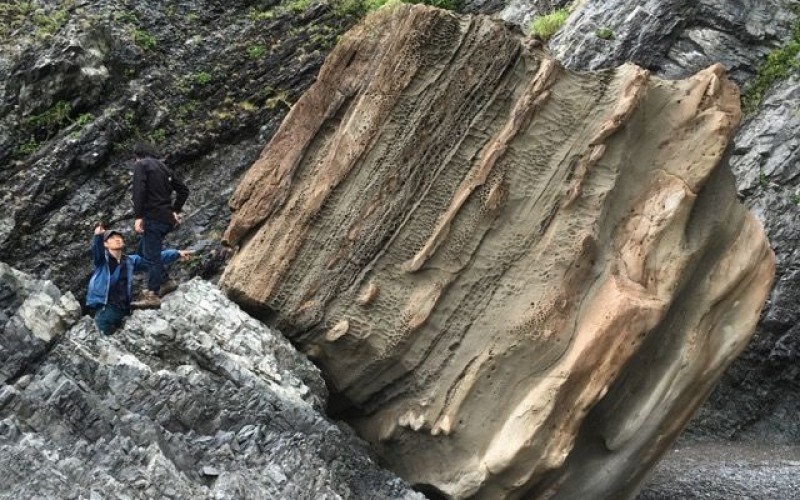
Earth’s “great dying” is contained by a slice of rock a few meters wide, shale and chert from 251 million years ago that run through Japan. Deposited at ocean bottom, this rock encompasses the Permo-Triassic boundary, when roughly 90 percent of marine species, and 70 percent of terrestrial ones, went extinct. This time remains earth’s greatest known extinction event. Devon Cole, a third year Geology phD candidate, will analyze these rocks to tell us about the end of life—as well as its genesis.
Her science, which traces earth’s history with chemistry, is both esoteric and highly technical. Its implications, however, are existential.
With YIBS support, Cole and a post-doctoral fellow in the Yale Metal Geochemistry Center, Don Penman, travelled to Japan to take samples of what’s known as the “P-T boundary.” There, the deep sea rock had been thrust up on land. They were following a mystery. Silica is missing.
Carbon, scientists believe, caused the giant die-off. According to Cole, silica should increase as well. For if a massive infusion of carbon into the atmosphere and ocean caused the giant die-off, the rock formed during that time should respond. Scientists reasoned that more carbon leads to warming and ocean acidification, as well as acid rain. Acid rain weathers rocks, freeing nutrients—and silica—to fuel ocean biological activity, which increases until it uses up all available oxygen. With no more oxygen, plants and animals die. Silica, they thought, should increase just like the nutrients freed by rock weathering. “You would expect a big flood of silica into the ocean. You would expect to see a record of that,” Cole said.
Cole’ s work, as with much geology, tracks events by looking at the chemical make-up of rocks. And the cycling of silica and carbon, how they move through atmosphere, ocean, rock, and animals, are intimately tied. However, dynamics between elements and animals and atmospheric conditions are complex. Increasing one condition does not necessarily have a simple effect on others. As Cole explained, the missing silica suggests processes that are usually paired, the cycling of carbon and silica, uncoupled during the great dying. Something unusual happened to silica, and knowing what may reveal more about how and why so many plants and animals died.
Cole and Penman hope that tracing elements will tell them about the living material. Scientists in Japan had already identified the rocks they wanted. Cole and Penman took samples and returned to the US to analyze the isotopes using machines at the Metal Geochemistry Center, which will weigh their silica to the neutron. The data will help Cole and Penman follow the material through its passage between rock and organisms. How did silica go from surface to seafloor? Was it consumed by microscopic, shelled ocean creatures, or precipitated out of the water as opal? Cole thinks in sources and sinks, addition and subtraction. Do the nuclear math, she said, and you can follow the events. The analysis could potentially help scientists model not just the past but also the future.
For there is a potential parallel between the great dying the coming climate change. “People love the P-T boundary because it’s a really good place to look at a rapid injection of co2 like we see today,” Cole explained. After the Permo-Triassic extinction event, the trophic structure of ocean communities was gutted. On ocean floors, only a handful of species remained. Then, after 8 million years, complex animal communities returned.
This return of life is closer to Cole’s main study subject. She usually looks further back in evolutionary history. “251 million years is the most recent thing I work on. Most is billions of years old.” Cole, and others in the Metal Geochemistry Center, ask about the beginnings of biology.
“How did we get to this habitable planet today? The majority of earth’s history is this totally crazy world that we wouldn’t even recognize. So why did it take so long to evolve complex life, what had to come together to make that happen? I focus mainly on looking at oxygen availability.“
“If we understand what the earth’s biosignature looks like for the majority of earths history it changes how we look for life in space. Earth having an oxygenated atmosphere is a remotely detectable signature, but if that’s only something that we’ve had for 500 million years, how likely are we to find something like that in space? How did we get that way?”
“I think being able to understand these low oxygen environments, and how you originally get life can tell us a lot about its ability to cope with really extreme environments.” In looking at silica, Cole gets at life itself—both on this planet, and, potentially, on others.
